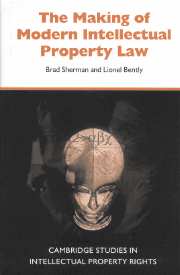Book contents
- Frontmatter
- Contents
- Acknowledgments
- List of abbreviations
- Table of statutes and bills
- Table of cases
- Introduction
- Part 1 Towards a property in intangibles
- Part 2 The emergence of modern intellectual property law
- Part 3 Towards an intellectual property law
- Part 4 Transformations in intellectual property law
- Bibliography
- Index
7 - Explanations for the shape of intellectual property law
Published online by Cambridge University Press: 29 May 2025
- Frontmatter
- Contents
- Acknowledgments
- List of abbreviations
- Table of statutes and bills
- Table of cases
- Introduction
- Part 1 Towards a property in intangibles
- Part 2 The emergence of modern intellectual property law
- Part 3 Towards an intellectual property law
- Part 4 Transformations in intellectual property law
- Bibliography
- Index
Summary
Valuing intangible property
In previous chapters we argued that mental or creative labour, the sweat of the brain rather than of the body, acted as a common denominator which united those areas of the law which we habitually regard as making up intellectual property law. In this chapter, our aim is to explain how and why it was that, within the more general category, patents, designs, copyright and (eventually) trademarks were carved out as separate and discrete areas of law. Although we recognise the important role played by the environment in which the law operates in shaping intellectual property law, our primary focus here - in line with our primary concern in exploring legal doctrine - is on those factors within the law that helped to shape the particular form that intellectual property law ultimately took. We will show that in spite of what many present-day commentators would have us believe, the emergence of modern intellectual property law was neither natural nor inevitable, nor was it an example of the law coming to occupy its proper philosophical position. Rather, the separation of intellectual property law into its now familiar categories was the product of a complex and changing set of circumstances.
In explaining the factors that helped to determine the shape of intellectual property law we wish to highlight two further points. First, we argue that the shape intellectual property law took, as well as the way this mode of organisation was explained, were strongly influenced by the particular type of subject matter that was protected and the way in which that subject matter was interpreted. Whilst we recognise that a range of factors helped to determine the shape of intellectual property law, it is not too far from the truth to say that the way in which the subject matter of intangible property was perceived is the key organising factor used to explain the shape that the categories took. At the same time we wish to show that the organisational role played by the subject matter of intellectual property law itself was to change over time. We hope not only to show the historically contingent nature of the legal categories and the way in which they were explained, but to highlight more clearly the non-natural and non-philosophical nature of intellectual property law.
Information
- Type
- Chapter
- Information
- The Making of Modern Intellectual Property LawThe British Experience, 1760-1911, pp. 141 - 158Publisher: Cambridge University PressPrint publication year: 1999
